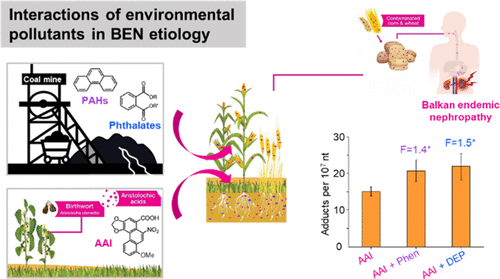当前位置:
X-MOL 学术
›
Environ. Sci. Technol.
›
论文详情
Our official English website, www.x-mol.net, welcomes your
feedback! (Note: you will need to create a separate account there.)
Analysis of Polycyclic Aromatic Hydrocarbons and Phthalate Esters in Soil and Food Grains from the Balkan Peninsula: Implication on DNA Adduct Formation by Aristolochic Acid I and Balkan Endemic Nephropathy
Environmental Science & Technology ( IF 10.8 ) Pub Date : 2021-06-14 , DOI: 10.1021/acs.est.1c00648 Wanlin Guo 1 , Jiayin Zhang 1 , Zhihan Sun 1 , William H Orem 2 , Calin A Tatu 3 , Niko S Radulović 4 , Dragan Milovanović 5 , Nikola M Pavlović 5 , Wan Chan 1
Environmental Science & Technology ( IF 10.8 ) Pub Date : 2021-06-14 , DOI: 10.1021/acs.est.1c00648 Wanlin Guo 1 , Jiayin Zhang 1 , Zhihan Sun 1 , William H Orem 2 , Calin A Tatu 3 , Niko S Radulović 4 , Dragan Milovanović 5 , Nikola M Pavlović 5 , Wan Chan 1
Affiliation

|
Balkan endemic nephropathy (BEN) is a chronic tubulointerstitial nephropathy affecting residents of rural farming areas in many Balkan countries. Although it is generally believed that BEN is an environmental disease caused by multiple geochemical factors with much attention on aristolochic acids (AAs), its etiology remains controversial. In this study, we tested the hypothesis that environmental contamination and subsequent food contamination by polycyclic aromatic hydrocarbons (PAHs) and phthalate esters are AA toxicity factors and important to BEN development. We identified significantly higher concentrations of phenanthrene, anthracene, diethyl phthalate (DEP), dibutyl phthalate (DBP), and benzyl butyl phthalate (BBP) in both maize and wheat grain samples collected from endemic villages than from nonendemic villages. Other PAHs and phthalate esters were also detected at higher concentrations in the soil samples from endemic villages. Subsequent genotoxicity testing of cultured human kidney cells showed an alarming phenomenon that phenanthrene, DEP, BBP, and DBP can interact synergistically with AAs to form elevated levels of AA-DNA adducts, which are associated with both the nephrotoxicity and carcinogenicity of AAs, further increasing their disease risks. This study provides direct evidence that prolonged coexposure to these environmental contaminants via dietary intake may lead to greater toxicity and accelerated development of BEN.
中文翻译:

巴尔干半岛土壤和粮食中多环芳烃和邻苯二甲酸酯的分析:马兜铃酸 I 和巴尔干地方性肾病对 DNA 加合物形成的影响
巴尔干地方病肾病 (BEN) 是一种慢性肾小管间质性肾病,影响许多巴尔干国家农村地区的居民。虽然普遍认为 BEN 是一种由多种地球化学因素引起的环境疾病,其中马兜铃酸(AAs)备受关注,但其病因仍存在争议。在这项研究中,我们检验了这样一个假设,即环境污染和随后的多环芳烃 (PAH) 和邻苯二甲酸酯对食品的污染是 AA 毒性因素,对 BEN 的发展很重要。我们在从地方性村庄收集的玉米和小麦谷物样品中发现了比非地方性村庄显着更高浓度的菲、蒽、邻苯二甲酸二乙酯 (DEP)、邻苯二甲酸二丁酯 (DBP) 和邻苯二甲酸苄酯 (BBP)。其他多环芳烃和邻苯二甲酸酯也在地方性村庄的土壤样本中检测到更高浓度。随后对培养的人肾细胞进行的遗传毒性测试显示出一个令人震惊的现象,即菲、DEP、BBP 和 DBP 可以与 AA 协同作用,形成水平升高的 AA-DNA 加合物,这与 AA 的肾毒性和致癌性有关,进一步增加他们的疾病风险。这项研究提供了直接证据,表明通过饮食摄入长期共同暴露于这些环境污染物可能会导致更大的毒性和 BEN 的加速发展。DBP 可以与 AA 协同作用,形成高水平的 AA-DNA 加合物,这与 AA 的肾毒性和致癌性有关,进一步增加了它们的疾病风险。这项研究提供了直接证据,表明通过饮食摄入长期共同暴露于这些环境污染物可能会导致更大的毒性和 BEN 的加速发展。DBP 可以与 AA 协同作用,形成高水平的 AA-DNA 加合物,这与 AA 的肾毒性和致癌性有关,进一步增加了它们的疾病风险。这项研究提供了直接证据,表明通过饮食摄入长期共同暴露于这些环境污染物可能会导致更大的毒性和 BEN 的加速发展。
更新日期:2021-07-06
中文翻译:

巴尔干半岛土壤和粮食中多环芳烃和邻苯二甲酸酯的分析:马兜铃酸 I 和巴尔干地方性肾病对 DNA 加合物形成的影响
巴尔干地方病肾病 (BEN) 是一种慢性肾小管间质性肾病,影响许多巴尔干国家农村地区的居民。虽然普遍认为 BEN 是一种由多种地球化学因素引起的环境疾病,其中马兜铃酸(AAs)备受关注,但其病因仍存在争议。在这项研究中,我们检验了这样一个假设,即环境污染和随后的多环芳烃 (PAH) 和邻苯二甲酸酯对食品的污染是 AA 毒性因素,对 BEN 的发展很重要。我们在从地方性村庄收集的玉米和小麦谷物样品中发现了比非地方性村庄显着更高浓度的菲、蒽、邻苯二甲酸二乙酯 (DEP)、邻苯二甲酸二丁酯 (DBP) 和邻苯二甲酸苄酯 (BBP)。其他多环芳烃和邻苯二甲酸酯也在地方性村庄的土壤样本中检测到更高浓度。随后对培养的人肾细胞进行的遗传毒性测试显示出一个令人震惊的现象,即菲、DEP、BBP 和 DBP 可以与 AA 协同作用,形成水平升高的 AA-DNA 加合物,这与 AA 的肾毒性和致癌性有关,进一步增加他们的疾病风险。这项研究提供了直接证据,表明通过饮食摄入长期共同暴露于这些环境污染物可能会导致更大的毒性和 BEN 的加速发展。DBP 可以与 AA 协同作用,形成高水平的 AA-DNA 加合物,这与 AA 的肾毒性和致癌性有关,进一步增加了它们的疾病风险。这项研究提供了直接证据,表明通过饮食摄入长期共同暴露于这些环境污染物可能会导致更大的毒性和 BEN 的加速发展。DBP 可以与 AA 协同作用,形成高水平的 AA-DNA 加合物,这与 AA 的肾毒性和致癌性有关,进一步增加了它们的疾病风险。这项研究提供了直接证据,表明通过饮食摄入长期共同暴露于这些环境污染物可能会导致更大的毒性和 BEN 的加速发展。











































 京公网安备 11010802027423号
京公网安备 11010802027423号